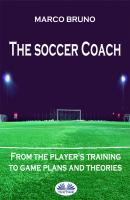The Soccer Coach. Marco Bruno
Чтение книги онлайн.

Читать онлайн книгу The Soccer Coach - Marco Bruno страница 4
Название: The Soccer Coach
Автор: Marco Bruno
Издательство: Tektime S.r.l.s.
Жанр: Спорт, фитнес
isbn: 9788873045502
isbn:
1 lack of understanding (isolate and explain the individual parts);
2 lack of intuition (the player does not see the action that takes place for three reasons:
- too crowded action;
- too fast action;
- plays with his head down.
1 lack of application (the player understands what it’s required from him, but he misses the execution because he tries to make things too difficult).
f) communication: all that has been said so far does not matter if the coach is not able to communicate. A coach can communicate in two ways:
1 by demonstration, highlighting the following qualities:
- correct game actions;
- actions carried out in a simple way;
- clear demonstration, highlighting the main factor;
- set a minimum target;
1 by the word: communication through speech is very important, but it depends on the conviction with which he speaks the coach. Before speaking, the coach must think for a moment about what he has to say to be sure of the meaning of the words; must avoid words or complicated speeches and watch the audience while talking. Finally, he must always speak positively because it is more effective to say “do this” instead of saying “you were wrong doing this”.
Communication in figures
We spend 70% of our lives communicating verbally. This time is as follows:
hearing 45%
talking 30%
reading 15%
writing 10%
Of all this we can remember:
of what we read 10%
of what we hear 20%
of what we observe 30%
of what we hear and observe 50%
of what we say 80%
of what we explain 90%
In a conversation we can:
listen 50% of what is said;
hear and listen 50% of what we listen (only 25%);
understand 50% of what we hear (only 12.5%);
believe 50% of what we understand (only 6.25%);
remember 50% of what we believe (only 3.125%).
How many times have we talked for a long time with our athletes?
What is left of our words?
3.125%!!!!!!!!!!
Everything else is forgotten.
To train means to communicate. Some speak but communicate little and struggle to enter into a relationship, while others speak too much and leave little time to listen.
Every teacher must always keep in mind the importance of the sequence:
I LISTEN = I FORGET
I SEE = I REMEMBER
I EXECUTE = I LEARN
Teaching during the game
The coach must be very skillful and careful in training matches. The training match is the culmination of the session, the final development of a good team action. The techniques and exercises in small groups are like pieces of a mosaic and teaching to put them into practice during the game is like trying to complete the mosaic. It is too optimistic to expect that those pieces go alone in their place. To obtain satisfactory and useful results, it is appropriate to establish:
- what to teach;
- where to teach;
- how to teach.
1) What to teach:
we must focus primarily on objectives aimed at improving teamwork.
Defense: reduce time and space; tackle and cover; mass defense.
Offense: creation and exploitation of spaces; passages and movements; mass offense.
All of this goes independently of a game strategy. Every player must learn to behave effectively in every situation.
Accustom the players to make the right calculation:
- between security and risk;
- the possibilities; know how to choose and perform what is best in a particular situation.(best choice)
2) Where to teach:
players must practice playing game actions in every part of the field. Improvements in offensive team play should come from the defensive three quarters of the field, in the same way the improvement of the defensive system should be achieved starting from three-quarters of offense. I think it is appropriate to carry out situational exercises in the different areas of the field or in the areas where we want these behaviors to be actually performed in the game.
3) How to teach: the methods that underlie the teaching are:
- control of the game (e.g. if a team has to train to create spaces on the central band of the field then the training must be limited to that area);
- game conditions (e.g. if you have to concentrate on the quick passage you have to impose the direct game, where possible, and in any case a continuous movement without a ball in advance on the decision of the partner to be able to give him the passage solution even before he receives the ball. If a shot is requested on the support, it is necessary to impose that the player must overtake the teammate to whom the ball has passed);
- stop the game. It is a method to show the players the advantages and disadvantages of their positions.
In this regard it is necessary that:
a) a signal known to all is fixed to stop the game (e.g. two whistle blows, but on this point I am convinced that the signal must necessarily be visual as the coach cannot use the whistle and therefore the players must visually recognize a situation common to all so that in recognizing it, everyone behaves as established in training);
b) the players stop so as not to alter the game situation you want to correct (it is advisable to stop the game to emphasize the theme, but not to deal with different themes).
- correct and try again: after having stopped the game it is important to try again in the correct way what has been done in the wrong way.
- thinking aloud: it is a method by which СКАЧАТЬ